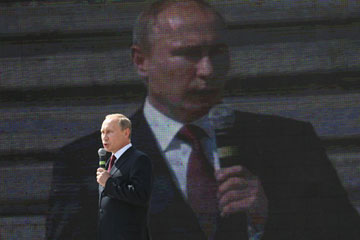
Russian President Vladimir Putin delivers a speech at the opening of the Barmaley Fountain on August 23, 2013 in Volgograd, Russia.
(3 of 7)
Breaking Out the Big Guns
On July 13, the day after snowden announced his plan to seek asylum in Russia, reveille sounded early at military bases across the country, rousing troops from their barracks in the middle of the night for the biggest round of war games since the fall of the Soviet Union. The snap drill, which Putin had ordered the previous evening, would field 160,000 military personnel, 1,000 tanks and scores of warships and aircraft across Siberia and the Russian Far East. The Defense Ministry, eager to head off any claims of aggression, insisted that the show of force was not aimed at any nation in particular.
Konstantin Sivkov saw it differently. Having served from 1995 to 2007 as a military strategist for the Russian General Staff, he says the war games had an obvious target--a joint attack from the U.S. and Japan against Russia's eastern frontier. "You have to think of it in terms of threats," he says. "And the threat to Russia over the past quarter-century has come from the Western world, and specifically the USA. They are our geopolitical opponents."
That attitude is echoed in Russia's official military doctrine. Adopted in 2010, it lists the expansion of NATO, the military alliance dominated by the U.S., as Russia's biggest external threat, and the bulk of Russia's defense budget is spent with that in mind. Over the past decade, that spending has managed to raise the armed forces from the disasters of the 1990s, when Russia's military was in such a dire state that a band of separatist guerrillas from the tiny region of Chechnya forced President Boris Yeltsin to grant them de facto independence. Putin came to power in 2000 with a promise to correct the mistake.
Before his first year in office was out, Chechnya had again been conquered and its capital destroyed, while the Russian military began a long march toward modernization. Today Russia has the third largest military budget in the world--$90 billion in 2012--behind the U.S. and China. Even though it is not involved in any wars, it drafts hundreds of thousands of men into the armed forces each year, maintaining a standing army of more than 800,000 soldiers, and spends the same proportion of its GDP--4.4%--on its military as the U.S. does. Last year, as he prepared to take his third term as President, Putin made the extravagant pledge to "completely rearm" the military at a cost of nearly $800 billion by the end of the decade. That would be piled on top of major pay hikes for police, teachers and other state employees, whose support has helped keep Putin's popularity rating above 60% in all the major polls.
